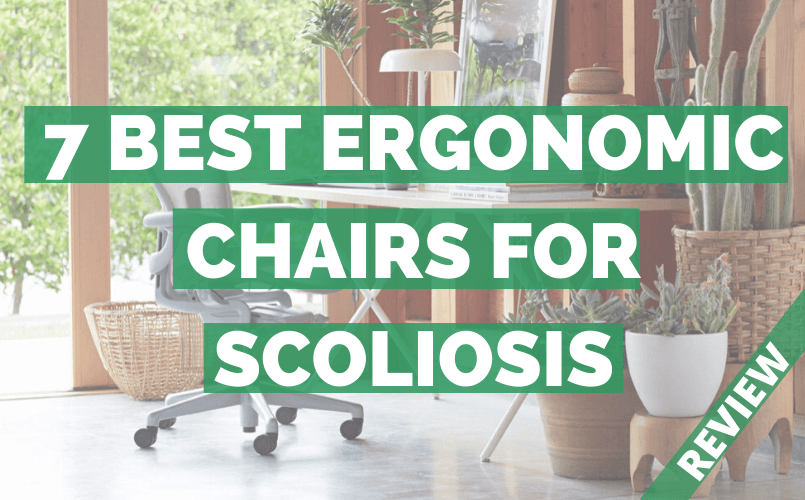- Good Office Chair (such as THIS MODEL HERE) will not help you treat scoliosis, but it may help to prevent further unbalance.
- Scoliosis makes the spine curve more to one side. Any part of the spine can be affected, but the most common areas are at the level of the chest and the lower back. Good Office Chair Can Make a Difference. Consult your doctor if you or your child have a severe curve or/and pain.

People with scoliosis can attest to more stress and strain during an average workday than those with a straight spine. Spending long hours sitting in a chair that aggravates the problem is definitely not helping.
That’s why it’s so important to invest in the right chair to help relieve as much stress as possible.
Here I’ve put together a list of the 7 best ergonomic chairs recommended by 3 chiropractors I came in contact with within the last 2.5 years.
MY RECOMMENDATION
- #1 Choice (Winner): .
- Budget Mesh Chair: .
- For Big & Tall: .
- Highly Adjustable: .
- Strong Lumbar Support: .
Table of Contents
Best Office Chair for Scoliosis (Updated List for 2024)
Having an ergonomic chair that helps support the length of the spine can relieve the pain of sitting, especially if you suffer from a curved spine.
While the cause of scoliosis hasn’t been determined, having ergonomic support that maintains a normal posture with as little effort as possible can help relieves the pain & discomfort associated with this condition.
As an ode to those that work hard despite their condition, I’ve gone through the work and put together a list of the 7 best ergonomic chairs that offer just the right support:
1. Herman Miller Aeron Chair – Best #1 Best Computer Chair for Scoliosis
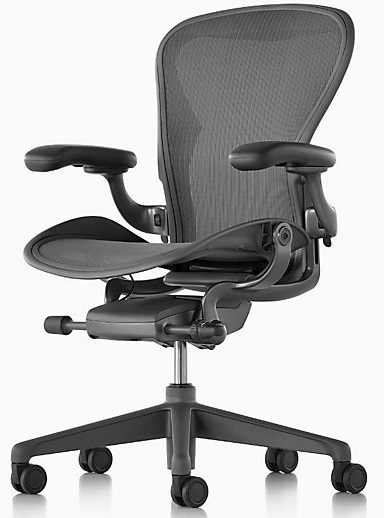 The Aeron from Herman Miller offers comprehensive support that’s designed to mold to the back of the sitter.
The Aeron from Herman Miller offers comprehensive support that’s designed to mold to the back of the sitter.
This makes it the top model for people with spinal deformities. It offers full back support, but without pieces that poke and prod at funny angles.
The elastomer seat and backrest offer support that gives where it needs to and holds tight where it must while providing a breathable surface that keeps hot spots cool and comfortable.
8Z Pellicle – The new elastomer mesh is designed to mold to the back, offering to give where needed and support where necessary. This encourages a proper posture while maintaining blood flow and offering a breathable surface that stretches to match your back.
Specialized Sacral and Lumbar Support – The adjustable lower back support is perfect to position in just the right place to give you the assistance you need exactly where it counts the most.
Natural Reclining – The Aeron moves from a forward position to a reclined position intuitively, making a good stretch easy and comfortable, just what you need when muscles start getting tired and cranky.
Forward Fit – The Aeron is now designed to sit slightly more forward, offering assistance even when you’re sitting up straight and paying special attention to your work.
Cross-Performance Health-Positive Design – The sitting position can become strenuous if your chair doesn’t move with you. The Aeron moves with you and actually improves spinal health as you’re busy with daily office tasks.
Fully Adjustable – With sizes for small, medium, and tall, the Aeron is also fully modifiable, seat height, tilt stop, and adjust so you can get the assistance that’s right for you.
You can buy a headrest as an additional option and this will make this – the best office chair for neck pain.
Key Takeaway: The Aeron is the class leader when it comes to ergonomic chairs that are fit for scoliosis. With all the healthy support and adjustments on offer, the negative of not having neck support is a small price to pay for an overall good chair. You can get The Original Headrest as an option which will make this chair complete!
.
2. Sihoo Ergonomic Office Chair – Best Desk Chair for Scoliosis
The Sihoo office chair offers a blend of mesh and upholstered ergonomic support. The backrest is a breathable mesh while the seat is soft yet supportive.
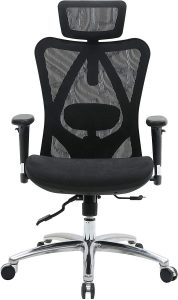 This is a sturdy, ergonomic chair that offers a wide range of adjustments that will ensure your comfort while giving you lasting assistance.
This is a sturdy, ergonomic chair that offers a wide range of adjustments that will ensure your comfort while giving you lasting assistance.
Fully adjustable – The headrest adjusts up and down and on a 45-degree tilt. The lumbar support adjusts both up and down and in and out. The adjustable armrests adjust up and down, in and out, and back and forth. The seat height and tilt are also modifiable.
Ergonomic – Using expert advice and everyday experience, Sihoo designed this chair to give support to the entire spine.
Wear Resistant and Sturdy – Made from high-quality mesh and stainless steel; this ergonomic office chair is both sturdy and hard-working.
Fully Tested – All aspects of the Sihoo have been quality and safety tested, from the seat to the casters, Sihoo are proud of the quality of their product.
Key Takeaway: The Sihoo ergonomic office chair is a strong and sturdy chair that offers a wide range of adjustments for superior comfort. But, if your back has a protruding curve is a strange place the unforgiving mesh may cut off blood circulation to the area over extended periods of sitting.
.
3. La-Z-Boy Trafford Office Chair – Best Recliner For Scoliosis
Comfort and style rolled into one. La-Z-Boy is known for its superior seating and it’s no different for the Tafford Office Chair.
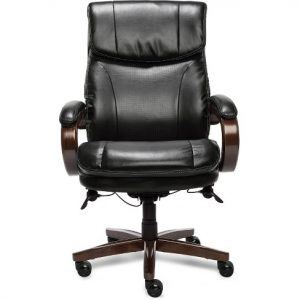 Cushioned from top to bottom, the Tafford offers comfort and support to the big and tall.
Cushioned from top to bottom, the Tafford offers comfort and support to the big and tall.
With quality, layered pillows, and flexible AIR lumbar, you get what you pay for with this chair.
Cushioned for Comfort – Deep layered ComfortCore memory foam pillows hug your back as you sit, while a headrest cradles your head and neck when you lean back. The armrests are cushioned.
AIR Technology – The lumbar support makes use of state-of-the-art tech that allows it to move when you move, so you get all the support you need without any of the pressure.
Adjustable – The seat and backrest height, recline, and tilt are modifiable,
Heavy Duty – The chair may hold up to 400 lbs with a chair dimension of 27.5 W” x 32 D” x 44.5″ to 47.5″ H. Built for the big, it could still be a comfortable throw for the small.
Key Takeaway: Reasonably priced the Trafford is a comfortable and supportive for the big or tall. It might be a bit too big if you’re a reasonably smaller person, but then again, the comfort the cushioned seat offers may be just what you need to keep you comfortable all day.
.
4. Alera Elusion Series Mesh Mid-Back Multifunction Chair
If you like having your upper torso free to move about during the day this is a good option for you.
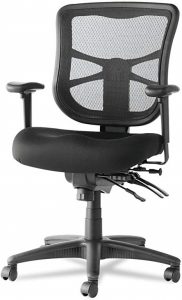 The Alera Elusion series is a good multifunctional chair for those that are busy bees even when you seat.
The Alera Elusion series is a good multifunctional chair for those that are busy bees even when you seat.
The seat glide and forward tilt give you support whether you’re leaning forward or back, while the infinite locking positions of the tilt lock allow you to choose the angle that works for you.
Adjustable – The seat tilt, seat height, armrest height and width, back angle, and seat glide are all fully modifiable.
Contoured Seat – The seat cushion is contoured for extra comfort while the waterfall edge relieves leg pain.
Mesh Back – The mesh back is breathable and contoured to fit a standard lumbar arch.
Stong and Sturdy Base – The base is rated five stars (but nobody knows by whom..), the casters make it is easy to move.
Key Take-Away: If you like a chair that is modifiable and only reaches halfway up your back, this is a good enough buy. But, the controls are difficult to use if you’re a beginner, the half-height backrest is also from mesh, which you should know by now, can become uncomfortable over time.
.
5. Modway Articulate – Best Mesh Chair for Scoliosis
The Articulate chair by Modway is a very economical ergonomic buy for those who need special support but can’t afford the pricey tags on some of the high-end models.
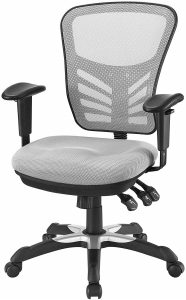 The mesh backrest is high, the mesh-covered plush seat is comfortable and the overall ambiance of the chair is rather pleasing (it’s available in six trendy colors). It’s not top of the range, but it does everything you need it to do.
The mesh backrest is high, the mesh-covered plush seat is comfortable and the overall ambiance of the chair is rather pleasing (it’s available in six trendy colors). It’s not top of the range, but it does everything you need it to do.
Mesh Backrest – The mesh backrest is ergonomically designed to give extra support where you need it.
Sturdy and supportive – The Articulate holds up to 336 lbs and is designed to do everything an office chair should do.
Adjustable – The levers are easy to use, and adjustments include seat height, tilt and angle adjustment, and tilt lock.
Extra Attention to Comfort – The pneumatic height adjustment and the contoured armrests add an extra bit of comfort; some other models in this category don’t offer.
Stylish – Available in six different colors, the Articulate is designed to improve the aesthetics of your office environment.
Key Takeaway: The Articulate is very affordable, but as with most things, expect what you pay for. In this case, that means very few modifiable parts and that the mechanisms start failing after a ( relatively short) period of time. But, if you’re generally gentle on furniture this is good value for money. The mesh is softer than the hard-wearing types, but does, unfortunately, give out over time.
.
6. Serta Style Hannah Office Chair
If soft support is what you’re looking for the Serta Style Hannah office chair is a good choice for you.
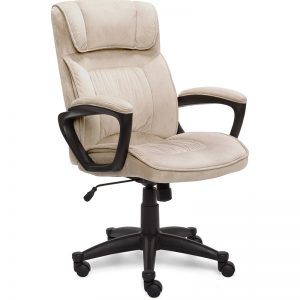 With soft upholstered body cushions and an extra pillow (attached) for head and neck support, the Serta is a dream come true for those who like softer seats.
With soft upholstered body cushions and an extra pillow (attached) for head and neck support, the Serta is a dream come true for those who like softer seats.
The lower back support offers extra ergonomic comfort, keeping your spine happy throughout your day.
Head and Lumbar Support – The head cushion and extra lumbar backing offer a relaxing seat that molds to the curves of your spine.
Soft Feel – The microfiber fabric is soft and silky, adding extra comfort to the entire chair.
Cushioned Armrests – When you get tired, the cushioned armrests add extra comfort.
Waterfall Seat – the edge tapers down, so the edge doesn’t cut off blood flow and circulation to and from the legs and feet.
Adjustable – The seat height and tilt are adjustable. The backrest is suitable for a 40-44” back.
Key Takeaway: If your back measures 40”-44”, this is a comfy solution for you, but even then the non-adjustable lumbar and headrest could become uncomfortable over time. This is a good option if a mesh or more rigid chair won’t work for you, but it is minimally modifiable which can result in other comfort issues.
.
7. CCTRO Mesh Ergonomic Office Chair – (Discontinued)
The CCTRO office chair has a mesh backrest for breathability and a cushioned seat for comfort.
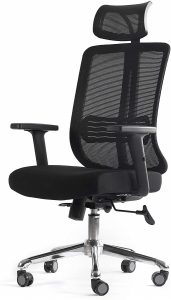 This is an affordable option that is conveniently modifiable in all the right places. It may not be top-of-the-range, but it is comfortable and with a good price tag.
This is an affordable option that is conveniently modifiable in all the right places. It may not be top-of-the-range, but it is comfortable and with a good price tag.
Comfortable and Breathable – The high-quality PU mesh backrest offers breathable yet sturdy support. The seat and armrests are cushioned for extra comfort.
Fully Adjustable (almost) – The 3D armrests adjust up and down, back and forth, and in and out.
There’s a tilt, and seat height adjust. The backrest and headrest are both modifiable. All that’s missing is in and out of lumbar adjustment.
Hardworking Casters and Base – The aluminum base is high quality, with explosion-proof chassis and rods all sit on top of 360-degree dual-wheel casters that are smooth and flexible on any surface.
Key Takeaway: This is an affordable and good buy. But, as with all mesh-backed chairs (except the Aeron) there is little give in the mesh, which can start to feel hard and painful after long hours of sitting. That being said, this is a good buy, especially if you’re working on a budget.
What Is Scoliosis?
Scoliosis is a spinal abnormality with unknown causes. Some people are just born with this often debilitating condition.
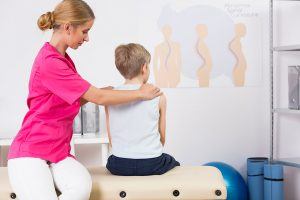 When someone has scoliosis, their spine curves left and right (curvature of the spine). While we all have an “S-shaped” spine, people with spinal deformities have an “S-shape” on two planes.
When someone has scoliosis, their spine curves left and right (curvature of the spine). While we all have an “S-shaped” spine, people with spinal deformities have an “S-shape” on two planes.
This places extra strain on the muscles of the entire back, including the shoulder and neck.
When a person with spinal deformity sits in a chair for a long time, their already strained muscles can cease up even more as they are constantly working to keep an upright position.
That’s why it can be so tiring for a person with a spinal deformity to spend a day at a desk.
And this makes it vitally important that they have the proper support to help ease as much of the strain their body undergoes as possible.
About Steelcase Gesture Chair
What Steelcase has done with this furniture design is been able to integrate hand gestures into the office. This new solution is geared toward the idea of being able to move and work in a way that will aid in productivity.
The gesture is a very important aspect to companies because it can keep the employees engaged and reduce the number of possible distractions. Steelcase recently showcased this innovative design at Think! exhibition for the architecture and design industry.
This all-in-one chair and bench let you adjust the angle, tilt, and tilting movement of the chair as you need. It’s part of the company’s workstation group. The platform tilts down for under-desk storage, and the seat extends out to create a standing desk.
You can add the $99 Grip roller wheels to the base for a more workout-like experience. The Gesture Chair from Steelcase takes simple, but effective interaction to a whole new level.
Once seated, you simply move your body, and the chair slides out into your desired position. Simple and intuitive, and thanks to the widely modifiable seating, you can tailor the height, tilt, and length of your recline.
And if your chair isn’t big enough, just slide it around the room with your feet on the rungs and put your feet up on the bed rails. Jensen Illustration’s Gesture Chair fits in between sitting and lying down or standing and leaning.
I also think this could be a great chair for going for a stroll or even taking a long flight! It is slightly shaped like a U and has arms to wrap around. The arms are good for support when sitting, and the curvy curves help distribute the weight in your shoulders and hips better.
What Main Features Make An Office Chair Best for Scoliosis?
There are a few things you want to look for in a chair when you have scoliosis:
- An adjustable backrest
- Enough give
- Proper support (for you)
While these may seem obvious things to look out for, let’s take a look at each in a bit more detail.
You want a backrest that adjusts, so you can move the lumbar support to where you need it, whether that’s higher or lower for you.
The best is a backrest that is upward and downward modifiable with lumbar support that can be adjusted up and down and in and out. But, getting all of these in a single chair can be pricey.
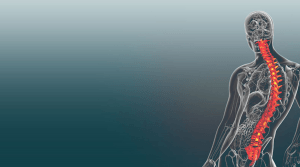
You also want a backrest that’s supportive, but that has a bit of giving. Sitting still on a relatively hard surface for a long time can aggravate your discomfort if you suffer from severe scoliosis.
The best option is a cushioned backrest, but the mesh can work too, provided that it isn’t too rigid.
The most important factor is that you need to get to know your spine and look for the features that offer you the support that you need.
Whether this means a soft backrest or one with firm lumbar support, a headrest, or the freedom to move your upper torso… This all boils down to your specific needs.
How Should I Sit If I Have Scoliosis?
With scoliosis, you want to make sure you’re sitting position is correct.
This means to seat all the way back in the chair and setting the backrest so that your pelvis isn’t tilting forward or back.
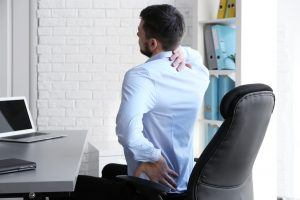
Unlike other people, you need a neutral pelvic position. When it’s tilted forward, you will be putting extra strain on the rest of your back. So make sure that the lumbar support is in just the right spot to support you.
It’s very important for you to use the full support of the chair by sitting back and upright in your chair instead of leaning either forward or back.
Stretching forward and back is, however good exercise for your back, so make sure to move around every now and again to keep your muscles from seizing up.
When at your desk and working, you don’t want a recliner, but when you’re taking a break, a relined massage or homemade traction could work wonders.
You could also try the halo traction brace if you find sitting for long hours unbearable.
Are Kneeling Chairs Good for Scoliosis?
A combination of strength and mobility training may be a good treatment for scoliosis. A person needs to get a spinal deformity diagnosis. A scoliosis diagnosis is usually made when the curvature is greater than 5 degrees and can be confirmed using imaging or a doctor’s physical exam. Sometimes people feel that they have been spinal deformity and are misdiagnosed as having other conditions. How to Diagnose Scoliosis.
A spinal deformity evaluation can be performed with a spinal deformity screening, but the body part that needs to be measured is usually not the one that’s the most obvious, such as a hip. Instead, a doctor measures the natural curvature of the spine from the front of the neck to the buttock. The spine curvature is measured during X-rays or physical examination. It can also be assessed by putting the spine in a twist to see how much of the spine is “curved” in each direction. People over age 50 and under age 30 should get a scoliosis screening done to be sure that they don’t have spinal deformity.
Sihoo Ergonomic Office Chair For Scoliosis
How many times have your back, hips, and/or knees been put to the test? The resulting pain is debilitating, and often the source of increased anxiety. This unfortunate condition is called scoliosis, and the culprit is any type of weight shift in your spine. Here’s where the office chair comes in: when you’re seated for a long period of time, you shift your weight from side to side and your spine slowly curves to follow. Scoliosis affects around 2.5 million Americans — a figure that will only increase with the Baby Boom generation — so the Ergonomic Office Chair may be the first line of treatment for anyone suffering from this back-related affliction.
These chairs have been engineered to compensate for some of the body’s curves, thus reducing the total level of strain on the spinal column. Lever Action Office Chair. Our office chairs are stuck with a stiff, clunky lever that you have to swing the seat around to recline. We’ve all sat in one or two. This is why they’re so uncomfortable.
Is Ergonomic Chair Good for Scoliosis?
Not Really. There are several problems with the ergonomic position, especially in children. The main ones are safety and cost. One arm-rest always to a child’s right makes a scoliosis diagnosis more likely. Instead, remove it or place it as low as possible. Comfort is a problem for many kids with a deviated spine.
Comfortable reclining chairs may encourage sleeping in the deviated spine position. Not to mention the overall safety issue with an unstable infant or toddler lying on a bed that could easily tip over, or be moved by accident. Don’t Sleep in a Defective Child’s Ergonomic Chair. The most important thing to remember is that a room can be designed to safely protect your child from sudden falls and accidents.
Are Saddle Chairs Good for Scoliosis?
You wouldn’t think a set of old riding saddles would be the best place to start, but an endocrinologist’s proof that they’re a safe choice caught the attention of more than 3 million people on Facebook. Oh wow, your saddles saved my life,” wrote one commenter on Facebook. “I’ve had scoliosis since I was 2 and wore a back brace.
I had surgery when I was in 10th grade. I took my brace off in 12th grade because my deviated spine got worse and was very painful. Then I got braces again and wore them for four years because I hated being crooked. I did PT for one year in high school but I hated it, it hurt my back so badly.
I continued using these saddle and stander machines until I graduated because it was the only way I could exercise without causing problems with my back.
What Should I Avoid If I Have Scoliosis?
Here are some things that people with scoliosis should avoid:
- Poor posture: Consistently achieving and sustaining good posture is essential for those living with scoliosis. When proper alignment isn’t applied, the spine can become curved or contorted even more than it already may be, resulting in increased discomfort and pain – so slouching, hunching over, or leaning in any direction should not be practiced. On the contrary, strive to sit upright with your shoulders back and chin parallel to the ground; you’ll find that doing this will provide a world of relief!
- Heavy lifting: For those struggling with deviated spine, lifting heavy items should be avoided at all costs due to the potentially detrimental impact on your back muscles. If you absolutely must pick up something, make sure that it is done in a proper form and with your legs rather than relying solely on your lower back.
- High-impact sports: Participating in high-impact sports, such as football, basketball, and gymnastics can be hazardous to individuals with scoliosis due to the potential for spinal damage. To prevent additional harm, it is recommended that these activities are either avoided or their frequency should be restricted.
- Repetitive motions: Engaging in repetitive motions like a golf swing or tennis stroke can cause uneven movements and potentially aggravate deviated spine. Therefore, individuals with this condition should either abstain from these activities or modify them to minimize the chances of further harm to their spines.
- Poor ergonomics: To alleviate strain on the spine and prevent the deviated spine from worsening, it is important to have ergonomically designed spaces at work or home. Individuals with scoliosis should be extra vigilant about ensuring that their workspace and living environment are conducive to keeping backaches away.
- High heels: Wearing high heels can be detrimental for those with a deviated spine, as it will disrupt their natural spinal curvature. Therefore, individuals living with this condition should avoid such footwear and instead opt for shoes containing a low or no heel to promote better alignment of the spine.
- Backpacks: Excessive weight on one shoulder can lead to unbalanced movement and aggravate deviated spine, making it more difficult for the body to stay upright. Therefore, individuals with scoliosis should consider investing in a backpack that has two straps in order to ensure an even distribution of weight across their back.
- Prolonged sitting: Sitting in one place for too long can be detrimental to your health, especially if you are living with scoliosis. To help alleviate the strain on your back muscles and prevent any worsening of the condition, it is important that you take regular breaks to stretch out and move around. Doing this will reduce tension in your spine and keep you feeling healthier throughout the day.
- Smoking: Smoking affects the body’s natural healing processes and can make deviated spine worse. To protect their health, those with scoliosis should either never pick up a cigarette or quit as soon as possible if they already smoke.
- Stress: Experiencing stress can aggravate pain and tenderness in individuals with scoliosis. Therefore, it is important to establish strategies for stress management such as physical activity, reflection, or counseling.
In conclusion, To minimize the risk of further damage to their spine, those living with scoliosis should pay attention to posture and ergonomics, avoid heavy lifting and high-impact sports activities, manage stress levels, as well as speak with a healthcare professional for personalized advice. By doing so they will be able to not only improve their quality of life but also help in preventing potential complications around the condition.
Frequently Asked Questions
Is it Better to Sit or Stand With Scoliosis?
When considering whether to sit or stand with scoliosis, individual factors and comfort play a crucial role. Scoliosis is a lateral curvature of the spine, and the optimal position depends on the severity of the condition, the degree of discomfort, and the specific needs of the individual. Scientifically, both sitting and standing postures have their own benefits and challenges for those with scoliosis.
Sitting: For individuals with scoliosis, sitting in a well-supported chair can help distribute body weight evenly and maintain a balanced posture. Proper lumbar support is essential to reduce strain on the spine’s curvature. However, prolonged sitting without periodic breaks can lead to muscle stiffness and discomfort. Ergonomic chairs with adjustable features can provide tailored support to accommodate spinal curvature and alleviate potential stress.
Standing: Standing can be beneficial for those with scoliosis as it reduces pressure on the spine and encourages better posture. When standing, the spine has the opportunity to align more naturally, potentially reducing pain and discomfort. However, prolonged standing without proper support can lead to muscle fatigue and may not be suitable for everyone, especially those with advanced scoliosis.
Incorporating Movement: Both sitting and standing can be enhanced by incorporating regular movement and stretching. Changing positions, stretching the spine, and engaging in gentle exercises can help maintain flexibility and alleviate discomfort.
Individual Factors: The decision between sitting and standing should be guided by individual factors. Consulting a healthcare professional, such as a physician or physical therapist, is crucial to determine the best approach based on the specific characteristics of scoliosis, any associated pain, and the individual’s overall health.
In conclusion, whether to sit or stand with scoliosis depends on the individual’s needs, the severity of the curvature, and comfort levels. Both sitting and standing have their advantages, but proper ergonomic support and regular movement are key to minimizing discomfort and maintaining spinal health. Seeking guidance from healthcare professionals ensures that the chosen posture aligns with the individual’s specific condition and promotes overall well-being.
Does Sitting Posture Affect Scoliosis?
Yes, sitting posture can significantly impact scoliosis, a medical condition characterized by an abnormal curvature of the spine. Maintaining proper posture is crucial for individuals with scoliosis as it directly influences the alignment and stability of the spine.
Individuals with scoliosis often experience an asymmetrical curvature of the spine, and poor sitting posture can exacerbate this condition. Prolonged periods of sitting with an improper posture may lead to increased strain on the spine and surrounding muscles, potentially worsening the curvature and contributing to discomfort.
To mitigate the impact of scoliosis on sitting posture, individuals are advised to adopt a conscious and supportive sitting position. This involves maintaining a neutral spine alignment, evenly distributing body weight, and avoiding positions that promote asymmetry. Ergonomic chairs with lumbar support can be particularly beneficial, providing additional support to the natural curvature of the spine and promoting proper alignment during prolonged periods of sitting.
It’s essential to note that while sitting posture plays a role in managing scoliosis-related discomfort, a comprehensive approach to scoliosis management may involve physical therapy, exercises, and, in severe cases, orthopedic interventions. Regular monitoring by healthcare professionals is crucial to ensure that the sitting posture adopted aligns with the individual’s specific curvature and medical recommendations. Overall, conscious efforts to maintain a proper sitting posture can contribute to the well-being of individuals with scoliosis by minimizing strain on the spine and supporting overall spinal health.
Is Scoliosis Considered a Disability?
Scoliosis is not automatically considered a disability. While scoliosis is a medical condition characterized by an abnormal sideways curvature of the spine, its classification as a disability depends on several factors, including the severity of the curvature, its impact on daily functioning, and individual circumstances.
In many cases, individuals with mild scoliosis may experience minimal symptoms and be able to carry out regular activities without significant limitations. However, more severe cases of scoliosis can lead to physical discomfort, reduced mobility, and other complications that may affect a person’s ability to perform tasks associated with work, school, or daily life.
Whether scoliosis qualifies as a disability is typically determined on a case-by-case basis, considering factors such as the degree of curvature, the presence of associated symptoms (such as pain or difficulty breathing), and the impact on functional abilities.
In some instances, individuals with scoliosis may meet the criteria for disability benefits or accommodations under programs such as Social Security Disability Insurance (SSDI) or the Americans with Disabilities Act (ADA). To qualify for disability benefits, individuals with scoliosis must demonstrate that their condition significantly impairs their ability to engage in substantial gainful activity and meets the criteria outlined by the respective disability program.
Furthermore, the classification of scoliosis as a disability may also depend on how it affects an individual’s ability to perform essential job functions or participate in educational activities. Employers and educational institutions are required to provide reasonable accommodations for individuals with disabilities, including those with scoliosis, to ensure equal access and opportunity.
Overall, while scoliosis itself is a medical condition that affects spinal curvature, its classification as a disability depends on various factors, including its impact on functional abilities, the presence of associated symptoms, and eligibility criteria for disability programs and accommodations. Individuals with scoliosis should consult with healthcare professionals and disability specialists to assess their specific situation and explore available resources and support options.
Final Words. Selecting the Best Ergonomic Scoliosis Chair
The very best chair is undoubtedly the Aeron, but that might not be practical if you’re working on a budget.
I would steer clear of the Alera Elusion unless the mid-back height really appeals to you.
If you’re looking for an affordable option, the Articulate or the CCTRO are decent options.
But if you want to splurge on a comfortable chair, rather go for the Lay-Z-Boy than the Hannah. While Hannah might have a softer feel, the Lay-Z-Boy is going to last a lot longer.
- TOP Ergonomic Choice: .
Do you need a headrest? Maybe the Sihoo is for you…
Need extra padding? Don’t go for mesh…
Whatever your needs are, there’s a chair on this list that’s going to be an excellent fit, so go through it again if you must.
As you should know, having a good office chair that’s got your back throughout the day is the key to living more comfortably with deviated spine. So far we have discussed non-surgical deviated spine treatment by changing your chair. If you have a severe problem, please consult your doctor for other possible scoliosis treatment options (braces, scoliosis traction chair, scoliosis surgery, etc..)
.
